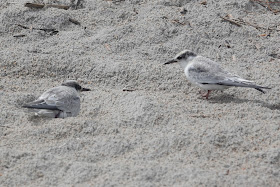 |
| photo by Hongjin Bian |
The Black Skimmers have spread out in the posting on the east side (facing the jetty) and there are now three separate areas of Skimmers along the beach as you walk towards the point (sound side). We have two beautiful and young Least Tern fledglings on the beach and lots of Black Skimmer chicks.
On the beach the morning of July 15th we counted 17 Black Skimmer chicks and one Common Tern chick on the east side (ocean/jetty side) and six nesting Skimmers (incubating eggs). Around the point sound side we counted 18 Black Skimmer chicks and one Common Tern chick. We estimate that there are more but because of the extreme heat, the birds were hunkering down in the grass, sand and under wing.
We have a rare Common Tern in the colony that has a metal band and wearing an orange flag on its left leg… identifying it as a Common Tern from Argentina!! We know it is a male as we saw it courting and mating on 6/30…and now nesting in front of the Skimmers and incubating eggs with its mate!! We were able to read the numbers on the metal band and report it! We will share whatever additional details we learn about this special Common Tern with you!
 |
| Photo by Hongjin Bian |
 |
| Photo by Hongjin Bian |
 |
| Photo by Hongjin Bian |
 |
| Photo by Hongjin Bian |
 |
| Photo by Hongjin Bian |
 |
| Photo by Hongjin Bian |
 |
| Photo by Hongjin Bian |
 |
| Photo by Hongjin Bian |
 |
| Photo by Hongjin Bian |
 |
| Photo by Hongjin Bian |
You will notice unattended Skimmer eggs on the beach.
If significant storms occur during nesting/incubation of eggs, it is common for several eggs to become non-viable. The parent bird’s efforts to protect all of the eggs in its nest from the wind, rain and colder temperatures are not always successful. Those eggs are removed from the nests by the birds and generally the ghost crabs are the clean-up crew!
 |
Photo by Stan Washlesky
|
 |
| Photo by Stan Washlesky |
 |
Photo by Stan Washlesky
|
 |
Photo by Stan Washlesky
|
 |
| Photo by Stan Washlesky |
 |
| Photo by Stan Washlesky |
 |
| Photo by Stan Washlesky |
REMINDER: There are chicks on the beach!
The chicks on the beach gives us a great opportunity to stop and take a look at the cuteness! But remember.....
- Birds have been nesting and incubating their eggs in the sand for 3 weeks
- Chicks can die from overheating (thermal regulation is critical). The sand is HOT!
- Parent birds will take the risk of people and gull/crab predators to get their hot chicks to cool on wet sand and drink at the water.
- Parent birds get very protective and dive and poop on people when the person is close to their chicks. This behavior alerts the Gulls that chicks are out.
- Black Skimmers may also use a “broken wing display” to draw people away from the chick.
- Laughing Gulls and the Great Black-Backed Gulls stalk and eat chicks.
- Protecting and feeding chicks is extremely energy intensive for the parent birds
All photos below by Camille Daniels…
We thank everyone who visits and helps us keep the sanctuary safe by keeping your respectable distance from the birds as they struggle to keep their eggs and chicks safe.
We hope to see you at one of our weekly FREE bird walks every Monday from 9 to 11 AM. Meet at the gazebo at Access 43 on Wrightsville Beach.






















































